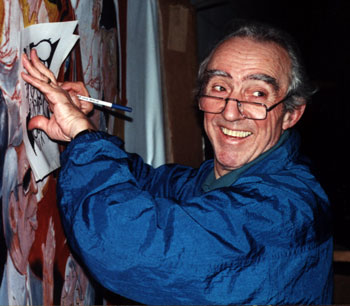
There may in fact be such a thing as a sure thing in horse racing. Every time cartoonist Pierre Bellocq, better known as Peb, is featured on the pages of the Daily Racing Form he's going to provoke you in some way, whether it's to laugh, to cry, to think or to just smile. It's been that way since April 1, 1955 when Peb's first cartoon, one coinciding with opening day at the old Jamaica Racetrack, appeared on the pages on the Morning Telegraph, then the sister paper of the Racing Form.
A year earlier, he arrived in the U.S., at the invitation of Laurel Race Course owner John D. Schapiro, to do artwork for the inaugural Washington, D.C. International, which gave him an introduction to American racing and led to the job at the Form.
Sometime he tackles sensitive issues, like the one where a horse chastises his jockey for excessive whipping. "You made your point, Mac," he says to the rider. Some are just about fun, like the one where a man, showing off his paddock filled with horses with incredibly long noses, says, "I concentrate on photo-finish breeding." Sometimes he knows just what to say and draw, like the poignant cartoon that showed a saddened Foolish Pleasure in his stall the morning after the Ruffian match race, wearing a Ruffian pin.
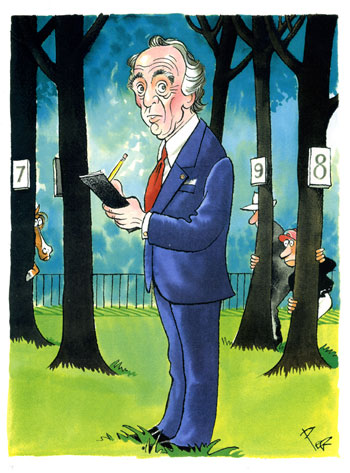
With his, imagination, his wit and his innate ability to bring out the true character of a person in his drawings, Peb probably could have gone on to be one of the great political cartoonist of his time, and, for a while, he was getting pulled in that direction. For a few years, Walter Annenberg owned both the Racing Form and the Philadelphia Inquirer and had Peb pulling double duty, doing political cartoons for the Inquirer and racing cartoons for the Form. In the early 1970s, Annenberg sold the Inquirer and the new owners of that paper wanted Bellocq to stick to politics. It was an easy decision. Horse racing, not politics, was his life. "I was born into racing," said Peb. "My father was a jump jockey in the south of France and may grandfather was a trainer. His father was a breeder. I was among horses right from the start." So Peb devoted the remainder of his remarkable career mostly to racing although he has enjoyed sketching other aspects of the horseworld as well..
Over the years, there have been so many classics. He says one of his favorites was the front-page cartoon for the Belmont Stakes, where he linked Philadelphia legend Smarty Jones to Philadelphia legend Rocky Balboa. He's always liked to link a race to current events. There was a cartoon depicting the notorious rogue Coronado's Quest before the 1998 Travers. He took one of President Clinton's recent explanations for his bad behavior, jumbled a few words and made them work for Coronado's Quest, who ended up saying, "Now, I must put it right. And I am prepared to do whatever it takes to do so. I have important work to do, real opportunities to seize." He even managed to make the horse and the President look alike. He says that cartoon is another one of his all-time favorites. Peb does Smarty Jones for the cover of Daily Racing Form.
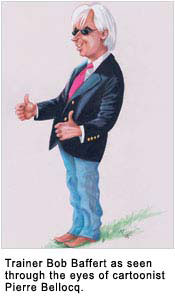 Another gift is his ability to bring out the character of the people he sketches. Jack Van Berg is rough and gruff. Julie Krone is an imp. Bob Baffert is confident and just a little bit cooler than anyone else. You always know more about his characters than the color of their hair or the shape of their noses. "It's almost some kind of mystical thing to grasp the inner character of a person," he said. "It's hard to explain. Naturally, you want to study the person and try to find out what motivates the person and what their character is and translate that into life." Some people are easy to draw. Some are not. "The hardest person I ever tried to draw was Eddie Maple," he said. "People like him that have fine lines and regular features are hard to do," Peb said. "I struggled with him for a long time before I got down his likeness. Some others have been great to do, like Eddie Arcaro, Cordero, Shoemaker, McAnally, Mandella, Frankel. Frankel is superb to draw. He looks like a cat out of Alice in Wonderland." Another gift is his ability to bring out the character of the people he sketches. Jack Van Berg is rough and gruff. Julie Krone is an imp. Bob Baffert is confident and just a little bit cooler than anyone else. You always know more about his characters than the color of their hair or the shape of their noses. "It's almost some kind of mystical thing to grasp the inner character of a person," he said. "It's hard to explain. Naturally, you want to study the person and try to find out what motivates the person and what their character is and translate that into life." Some people are easy to draw. Some are not. "The hardest person I ever tried to draw was Eddie Maple," he said. "People like him that have fine lines and regular features are hard to do," Peb said. "I struggled with him for a long time before I got down his likeness. Some others have been great to do, like Eddie Arcaro, Cordero, Shoemaker, McAnally, Mandella, Frankel. Frankel is superb to draw. He looks like a cat out of Alice in Wonderland."
Like most of the rest of us, he enjoys the aspects of the sport that bring out its beauty and its class. You'll often find Peb working on a sketch in the paddock at Saratoga, but it will be a rare day that he's at Aqueduct in the winter. " I have tried to bring my heritage and my background from France into this job," he said. "In France and in England, you still find an element of sport and beauty that is at the heart of the racing there. I try to depict that in my drawings. In America, the outlook is a little different. I try to export from my country the sophistication, the charm and the beauty of horse racing and translate it into racing in this country with the addition of humor. Sometimes people may find what I do to be esoteric because I still look at things through the eyes that fell in love with European racing." No such explanations are needed. The important part if that he makes people laugh and think and has done so for over 50 years. It's been a remarkable run.
Courtesy of Bill Finley
Special to ESPN.com
Peb Bellocq Selected To National Museum Of Racing’s Joe Hirsch Media Roll Of Honor
 Renowned Eclipse Award-winning cartoonist Pierre “Peb” Bellocq and the late Eclipse Award-winning writer William Leggett have been selected to the National Museum of Racing's Joe Hirsch Media Roll of Honor.
Bellocq, 94, was born in France in 1926. At age 19, the French racing journal France Courses gave him national exposure by publishing one of his cartoons of a jockey. Bellocq signed the drawing as “Peb,” a signature that became his lifelong moniker.
By 1954, Bellocq's work had achieved international acclaim and he was contracted by Laurel Park owner John D. Schapiro to do drawings for the prestigious Washington, D.C. International Stakes. Bellocq decided to relocate to the United States and in 1955 accepted an offer to work as the staff cartoonist for the Morning Telegraph and its sister paper, the Daily Racing Form, a job he held until December 2008. Early in this career, Bellocq also produced political cartoons for the Philadelphia Enquirer while simultaneously working for the Form. Bellocq eventually transitioned his primary focus to thoroughbred racing.
“My father was a jump jockey in the south of France and my grandfather was a trainer. His father was a breeder. I was among horses right from the start,” Bellocq said.
Along with his work for the Form, Bellocq has been commissioned by numerous racetracks to produce vibrant murals capturing the flavor of the sport. His large-scale cartoon collages became fixtures at tracks such as Churchill Downs, Del Mar, Arlington, Oaklawn, Aqueduct, and The Meadowlands.
Bellocq has also produced several books; his first, published in 1957, consisted of 150 cartoons and was titled “Peb's Equine Comedy.” Bellocq also illustrated the 1969 Joe Hirsch book “A Treasury of Questions and Answers from the Morning Telegraph and Daily Racing Form.” In 2004, he created drawings for author Ed Hotaling's book on Hall of Fame jockey Jimmy Winkfield, whom Bellocq had known personally when the rider was living and racing in his hometown of Maisons-Laffitte.
Bellocq has received numerous awards for his work, which has been exhibited extensively. In 1980, he received an Eclipse Award for his contributions to racing and he was presented The Jockey Club Medal in 2016. Bellocq also received the National Cartoonists Society 1991 Sports Cartoon Award and their 1999 Newspaper Illustration Award. In 1998, the Daniel Wildenstein Art Gallery in New York held an exhibition of Bellocq's work titled The Racing World in Sketch and Caricature. From July 2004 through December 2005, the National Museum of Racing and Hall of Fame put on a special exhibition of his works titled Peb: The Art of Humor, which celebrated his 50th anniversary of horse racing artwork in the United States
Cartoonist ‘Peb’ Bellocq Receives The Jockey Club Medal
Pierre “Peb” Bellocq, the legendary horse racing cartoonist, received The Jockey Club Medal on Saturday night for exceptional contributions to the Thoroughbred breeding and racing industry.
The presentation was made by Stuart S. Janney III, chairman of The Jockey Club, in Saratoga Springs, N.Y., at a dinner hosted by The Jockey Club.
“Peb's artwork has been revered in the horse racing industry for more than 50 years,” said Janney. “He has brought color and humor to our sport through his ingenious cartoons, and we are pleased to honor him for his dedication.”
Bellocq, an 89-year-old resident of Princeton, N.J., has chronicled horse racing through sketches, caricatures, and cartoons for more than half a century in the United States and his native France.
In addition to his sketches in the Daily Racing Form, and more recently in Thoroughbred Daily News, Bellocq has painted murals at several racetracks. He received an Eclipse Award for Outstanding Contributions to Racing in 1980.
Previous recipients of The Jockey Club Medal are Daniel G. Van Clief Jr. (1984), Jean Romanet (1985), Richard L. Duchossois (1986), Jack Van Berg (1987), Dennis Swanson (1988), Joe Hirsch (1989), Dr. Charles Randall (1990), Dr. Manuel A. Gilman (1991), R. Richards Rolapp (1992), Kenneth Noe Jr. (1993), Dr. Larry Bramlage (1994), Alan Marzelli (1998), Nick Nicholson (1998), Hans J. Stahl (2003), Louis Romanet (2007), Tom Durkin (2014), and Ogden Mills Phipps (2015).
ADDENDUM:
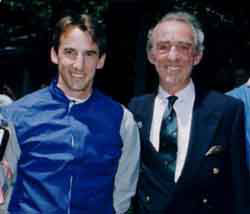 PEB
is also the founder and president of the Amateur
Jockeys Association, an organization
which fosters the love of competitive
racing by those who ride purely for the
enjoyment of the sport. PEB
is also the founder and president of the Amateur
Jockeys Association, an organization
which fosters the love of competitive
racing by those who ride purely for the
enjoyment of the sport.
"Racing
started out with amateurs and erupted
into the sport it is today," he said
during one of his many visits to Saratoga
Springs to work on "L'Etalon Vert."
"The (amateur) sport is huge in Europe
... The problem in this country is the
word 'amateur.' In France it means 'for
pleasure'; in America it means 'doesn't
know what they are doing," he laughed.
The
AJA organizes races at almost every race
track on the East Coast (including Saratoga)
and features primarily exercise riders
who have a passion for riding but not
necessarily the opportunity or the size
requirements to become professional jockeys.
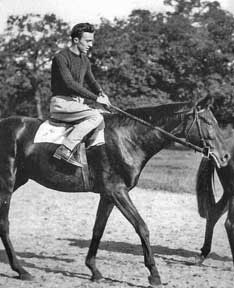
PEB
aboard Ma Jolie training to be an Amateur
Jockey in the 1950's
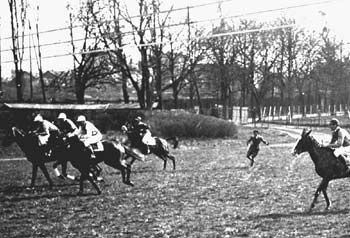
| PEB
RACING AGAINST THE PRINCE ALY KAHN
AT ST. CLOUD. PEB IS IN THE LEAD AT
THE START. THE ALY KAHN IS BEHIND
THE 3 WHITE CAPPED JOCKEYS ON THE
HORSE WITH THE SHADOW ROLL. Says PEB:
"Prince Aly Khan was making his
"debut" at Saint-Cloud after
the war under the eyes of his new
bride Rita Hayworth! Of course he
was 4 kgs. overweight and finished
dead last. I finished 6th for my first
ride ever on a horse named Moustell
owned by a Swiss owner-trainer named
Muri." |
|

